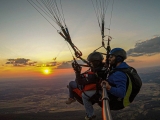La Pedriza de Manzanares is a picturesque and unique location in the world, a landscape of exceptional scenic and ecological value. We are fortunate to enjoy it just 45 km from the capital, as it lies within the Parque Regional de la Cuenca Alta del Manzanares in the province of Madrid.

A collection of granite boulders and crags with peculiar shapes transports us to another dimension, where you’ll feel more like an inhabitant of a legendary realm than a mere hiker. Many of its rocks defy gravity in improbable balances, shaped tirelessly over thousands of years by wind, water, and ice in the highest areas of the massif. The scent of its rockroses will intoxicate you, while the unusually high radon content in its granite composition will recharge your energy. Resting in one of its nooks will immerse you in peace and tranquillity.

But if we had to highlight one rock, crag, or boulder in this singular landscape, we’d undoubtedly point to the patriarch and lord of the area, where the Pedriza converges closest to the village of Manzanares el Real (Pedriza Anterior). El Yelmo (1,735m), also known as El Diezmo, owes its name to its resemblance to the medieval helmet (yelmo) or tithe (diezmo). Its silhouette will powerfully capture the hiker’s attention from any point in the park, especially from Manzanares.

The first recorded ascent in La Pedriza was to this very crag, undertaken by the renowned geologist Casiano del Prado around 1864—though local shepherds likely climbed it earlier. It’s assumed they used the normal route on the north face.
Its summit is the most visited in the entire park, thanks to the simplicity of its standard routes. Virtually any hiker with basic scrambling skills, determination, and a bit of courage can reach the top, where the views are unmatched. To the north, it encompasses the entire amphitheatre of the Pedriza Posterior, part of the Cuerda Larga ridge, and La Maliciosa; to the south, the Castilian plateau stretches toward Madrid.

We’ll leave the bustling normal route on the north face to explore the secrets of its southwest flank, discovering a straightforward, beautiful itinerary with an alpine atmosphere that spills into the Hueco de las Hoces ravine. A delight for all our senses.
Though straightforward, this route requires some experience and skill in finding the correct ascent line, as well as carrying the necessary gear and basic rope-handling knowledge for safety. While it’s often used as a descent route for the south face climbing lines—and it’s not uncommon to see climbers downclimbing unroped—we must remember they are far more experienced. For novices, roping up is highly advisable, especially on sections exposed to the voids of the south and north faces.

The route is named after local guide Valentín Parra, who frequently used it with clients. The first ascent was credited to Ultano Kindelán and Pablo Martínez del Río in 1913.

The route begins at an obvious dihedral to the left of the south face’s large left gendarme. Climb it and continue leftward along the gully to a group of small trees and a ledge. Traverse west (left) to the base of a straightforward slab with a thin crack. Ascend the easiest section until the terrain steepens, requiring a short downclimb to reach the west spur of the crag. Follow the clearest line upward via leaning cracks and slabs, with occasional harder moves on bulges, to reach Yelmo’s summit plateau without major difficulty. Descend via the normal route on the north face.

This is the second easiest route to Yelmo’s summit. After the initial dihedral (where difficulties peak at III grade), the rest of the route is simpler (II grade), involving sustained scrambling in breathtaking surroundings.

A challenging climb for scrambling novices, but a stroll for seasoned climbers.

TECHNICAL DETAILS
- Difficulty: Moderately Difficult (Max Grade: III)
- Length: 120m | Elevation gain: 700m
- Estimated time: 4 hours total
- Approach: 1h 30min | Ascent: 1 hour
- Start point: Cantocochino car park

It’s crucial to master safety techniques for steep terrain and gear usage. If unsure, hire a professional for training or join a certified Mountain or Rock Climbing Guide to ensure safety and maximise enjoyment of the landscape and activity.











